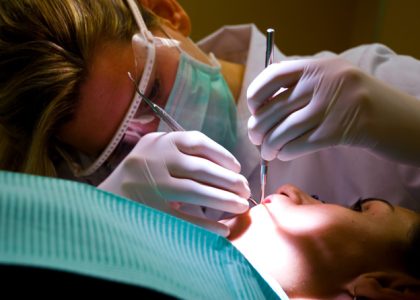Glenview’s premier dental health provider
To maintain good oral hygiene between dental visits, you need to adopt a few essential habits that can significantly impact your dental health. Start by establishing a consistent brushing routine, but don’t overlook the importance of flossing and using mouthwash. You might also want to consider how your diet and hydration levels play a role in keeping your mouth healthy. By making these small adjustments, you can stay ahead of potential issues. Curious about the specific strategies that can enhance your oral care routine?
Establish a Daily Brushing Routine
To maintain good oral hygiene, you should brush your teeth at least twice a day for two minutes each time. This daily routine is crucial for removing plaque and preventing cavities. Use a soft-bristled toothbrush and fluoride toothpaste to effectively clean your teeth without damaging your gums.
Begin by positioning your toothbrush at a 45-degree angle to your gum line. This angle helps you reach the plaque that builds up along the gums. Use gentle, circular motions to clean the outer surfaces of your teeth, and don’t forget to brush the inner surfaces as well. Make sure you also scrub your chewing surfaces thoroughly, where food particles can get trapped.
While brushing, pay attention to your tongue too. It can harbor bacteria that contribute to bad breath, so gently brush it or use a tongue scraper.
Establishing a consistent brushing routine not only keeps your mouth fresh but also sets a positive example for those around you. You can even set reminders on your phone to ensure you stick to it, especially during busy days.
Consistency is key for maintaining a healthy smile!
Floss Regularly and Effectively
How often do you floss? Regularly incorporating this practice into your oral hygiene routine is essential for removing food particles and plaque from between your teeth, where your toothbrush can’t reach. Ideally, you should floss at least once a day. This simple action can significantly reduce your risk of cavities and gum disease.
When you floss, use about 18 inches of floss and wrap the ends around your fingers for better control. Gently slide the floss between your teeth, making sure to curve it around each tooth in a C-shape. This technique helps clean both the tooth’s sides and beneath the gumline. Don’t rush—take your time to ensure you’re effectively removing debris and plaque.
If you find traditional floss tricky, consider alternatives like floss picks or water flossers. These tools can make the process easier and more enjoyable. Remember to be gentle to avoid injuring your gums. If you experience pain or bleeding, consult your dentist, as this could signal a gum issue.
Incorporate Mouthwash Into Your Routine
Incorporating mouthwash into your daily routine can enhance your oral hygiene by providing an extra layer of protection against plaque and bad breath. Using mouthwash doesn’t replace brushing and flossing; instead, it complements these essential practices. Choose a mouthwash that suits your needs, whether that’s for freshening breath, fighting cavities, or controlling gum disease.
To get the most out of your mouthwash, rinse your mouth for about 30 seconds after brushing and flossing. This allows the active ingredients to work effectively. Don’t swallow the mouthwash, as it can contain ingredients not meant for ingestion.
Be mindful of alcohol-based mouthwashes, as they can cause dry mouth, which might lead to other oral health issues. If you experience dryness, consider alcohol-free alternatives that still provide antibacterial benefits.
You can also use mouthwash at different times during the day, especially after meals or snacks, to help remove food particles and bacteria. Just remember, consistency is key. By making mouthwash a regular part of your routine, you’ll enjoy fresher breath and a healthier mouth, ultimately leading to better oral health between dental visits.
Maintain a Healthy Diet
Maintaining a healthy diet plays a crucial role in supporting your oral hygiene and overall health. The foods you choose can significantly impact your teeth and gums.
Incorporate a variety of fruits and vegetables into your meals; they’re rich in vitamins and minerals that strengthen your teeth. Crunchy fruits and veggies, like apples and carrots, also help clean your teeth as you chew.
Limit sugary snacks and beverages. Sugar fosters the growth of harmful bacteria in your mouth, leading to cavities and gum disease. Instead, opt for whole grains, lean proteins, and dairy products that provide essential nutrients without the added sugars. Foods high in calcium, like yogurt and cheese, help maintain strong teeth and bones.
Don’t forget about fiber! High-fiber foods can stimulate saliva production, which naturally protects your teeth against decay. If you crave something sweet, choose healthier alternatives, like dark chocolate or fruit, to satisfy your cravings without compromising your oral health.
Stay Hydrated for Oral Health
Staying hydrated is essential for keeping your mouth healthy and preventing issues like dry mouth, which can lead to tooth decay and bad breath.
When you drink enough water, you help your body produce saliva, a natural defense against cavities and gum disease. Saliva washes away food particles and neutralizes acids that harmful bacteria produce, making it a key player in your oral hygiene.
Aim to drink at least eight glasses of water a day, or more if you’re active or live in a hot climate. If plain water’s not your thing, try adding slices of fruit or herbs for a refreshing twist.
Avoid sugary drinks like soda and fruit juices, as they can contribute to tooth decay.
Remember to sip water throughout the day, especially after meals. This simple habit can significantly reduce the risk of dry mouth and keep your breath fresh.
If you find yourself feeling thirsty often, it might be a sign that you need to increase your water intake.
Conclusion
By following these simple steps, you can maintain excellent oral hygiene between dental visits.
Make brushing and flossing a part of your daily routine, and don’t forget to use mouthwash for extra protection.
Eating a balanced diet and staying hydrated will also support your oral health.
Remember, good habits today lead to a brighter smile tomorrow.
So, take charge of your dental care, and enjoy the confidence that comes with a healthy mouth!








